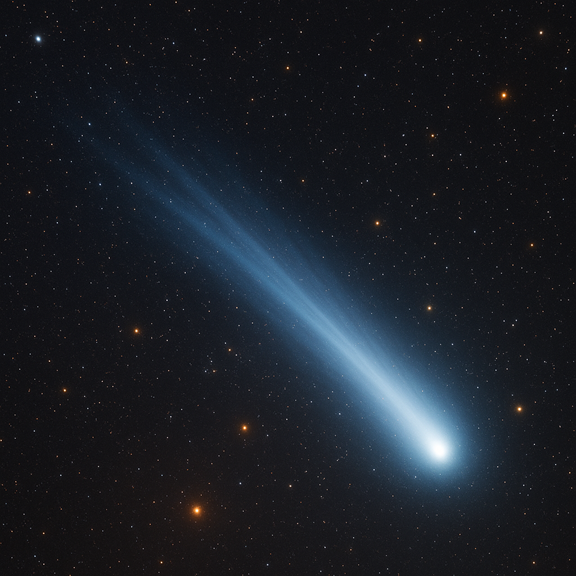The interstellar menace
There has been a lot of talk online in recent months about “ATLAS/31.” Actually the correct name is 3I/ATLAS: that “I” is a capital “i” (stands for interstellar), often mistaken for “1.” 3I/ATLAS is an interstellar object discovered on July 1, 2025 by the ATLAS project in Chile; it is only the third confirmed visitor from outside our Solar System. According to NASA and MPC, it behaves like a comet on a hyperbolic trajectory, i.e., not bound to the Sun.
A recent study, published by Avi Loeb, an Israeli physicist, proposes that the interstellar object 3I/ATLAS may be a hostile alien probe. Supporting evidence includes its anomalous trajectory, high velocity and very close passage to planets such as Jupiter, Mars and Venus – circumstances that would make it ideal for extraterrestrial espionage missions. In addition, its temporary hiding behind the Sun during its period of maximum brightness is interpreted as a strategic choice.
When Earth-based telescopes intercepted interstellar comet 3I/ATLAS, scientists spoke of a natural visitor, a fragment of ice and dust born in a distant star system. But soon, the official narrative began to crack. Orbital calculations revealed subtle maneuvers, unexplained deflections, accelerations not just due to outgassing. It appeared that the object was following an intentional trajectory.
Many have taken to calling it Atlas 31, turning the acronym into a dark code, the portent of a final event. In the digital plazas of the world they speak of “alien invasion,” “mother ship masquerading as a comet.” Some recall ancient prophecies: the “star heralding doom,” signs in the heavens before the fall of empires.
Theories of ‘imminent invasion suddenly become plausible. the signal that Earth is not alone, but also that it is not safe. If Atlas 31 is the first wave, what followed it may mark the beginning of the end of the world.
As the lights of 3I/ATLAS shine on the horizon, human civilization finds itself suspended between two options: resist the unknown or yield to the fate written in the stars.
However, the scientific community is highly critical:
– He defines these beliefs as baseless, useful only for generating clicks and media reactions.
– He reiterates that the data collected so far clearly indicate that 3I/ATLAS is a natural interstellar comet, not an explicitly alien technological vehicle.
IN fact here is what we know nooi now about this mysterious object:
– No threat to Earth: the closest passage to our planet will remain around ~1.8 AU (≈270 million km.
– Timing: perihelion is expected in late October 2025, just inside the orbit of Mars; during the weeks of maximum approach to the Sun, from Earth the object will be close to its conjunction with the Sun, thus difficult to observe, and then will be visible again in early December.
– Why it makes headlines: some articles and an essay by Avi Loeb have proposed more speculative scenarios about its nature (mostly hypotheses for discussion, not scientific consensus). The official classification remains “interstellar comet.”
BUT what does the Bible say and where do biblical prophecies and rabbinic tradition come into play?
1) “Signs in the heavens”:the prophetic liguage of the Bible.
The Hebrew Bible often uses heavenly language as a theological metaphor. The prophet Joel speaks of “wonders in heaven and on earth…the sun will change to darkness and the moon to blood” before the “day of the Lord” (Gl 2:30-31). It is an apocalyptic register that links celestial phenomena to decisive historical moments, but without identifying specific comets.
Job 38:31 also questions man about his powerlessness before the cosmic order: “Can you bind the Pleiades or loosen Orion’s belt?” It is a passage that emphasizes divine dominion over the cosmos rather than the prediction of timely astronomical events
2) “A star shall come out from Jacob”: from the biblical text to historical reinterpretation
These traditions show how the heavens were also read as prophetic , according to the sensibilities of the time Numbers 24:17 (“a star shall come up from Jacob”) was read messianically in Jewish and Christian circles. In Roman times, Rabbi Akiva applied that verse to the leader of the 132-135 revolt, who has since been nicknamed Bar Kokhba (“Son of the Star”). The association between “star” and historical breakthroughs is thus ancient, but it concerns historical figures (and symbols) rather than concrete comets.
3) The Sages and Comets: Talmud.
Various mentions of celestial phenomena appear in rabbinic literature:
– Horayot 10a recalls “a star that appears every 70 years and diverts sailors,” often related (in retrospect) to Halley’s comet.
– Other sources discuss the crossing of Orion by a comet as an ominous sign-with the clarification that what appears to pass “is the glow,” not the body of the comet.
The first-century historian, Josephus Flavius, reports that before the fall of Jerusalem there appeared “a sword-like star” and a comet that lasted a year-elements read then as omens. This is an example of how history and celestial signs have been connected in religious memory.
4) Mysticism and signs: the Zohar
Images of stars from the Levant surrounded by other stars “for seventy days” before messianic revelations recur in Kabbalistic literature (e.g., Zohar, Shemot). These are symbolic and not normative texts, but they show how an “extraordinary star” could become an icon of historical passages in Jewish sensibility.
5) The rational position: Maimonides versus astrology.
On the other hand, Maimonides (Rambam) in his famous Epistolary on Astrology refuses to base decisions or beliefs on celestial omens. For him, stars and planets are part of divine creation but do not determine human destinies-a highly influential ethical compass to this day.
But we can certainly say that 3I/ATLAS is a “wandering star” out of the ordinary, and as such can awaken symbolic themes present in the Bible (Joel’s “signs in the heavens”) and tradition (the messianic “star” of Nm 24:17; rabbinic accounts of comets and celestial cycles). These parallels are primarily literary and theological, not astronomical predictions. In the coming days g observers will try to characterize the composition (ices, dust, possible molecules) and dynamics of 3I/ATLAS during useful observational window and geometry, especially after perihelion when it will return angularly away from the Sun. This is a rare opportunity to compare a body born in another star system with our comets. For the audience: no “balcony shows,” but a great science story in progress.
Our opinion and advice is to return “To the law, to the testimony!” (Isa. 8:20).
Not to the whispers of fears, not to the clamors of speculation, but to the living Word that has been given to us. Truth is measured not by the signs of heaven, nor by the omens of comets, but by the voice of the Lord Jesus Christ.
Today many people look at Atlas 31, the interstellar comet, as if it were an omen of doom or the announcement of an invasion. But we know that Scripture is clear: our hearts should not be troubled. Jesus has told us, “I am coming soon.” He did not leave us in uncertainty, but delivered to us the certainty of his glorious coming.
Although Atlas 31 is not the sign of the end of the world, and it probably is not, if it were, it would only confirm Jesus’ words, “Behold, I am coming soon, and my reward is with me” (Rev. 22:12). The heavens may tremble, the stars may fall, the peoples may stir, but his promise remains firm.
Faith does not rest on a comet, but on the Cross and Resurrection. Hope is not kindled by a glow in the firmament, but by the light that already shines in the heart of those who believe. The fear of the world must not replace the holy expectation of the coming Bridegroom.
We are called to be ready: not with shelters and alarms, but with pure hearts, lighted lamps and oil of faith. For the Lord will come like a thief in the night, not announced by astronomical calculations, but expected by those who watch in prayer.
Atlas 31 will pass and be forgotten, but Jesus’ words will never fall to the ground without fulfillment. His promise will never be in vain. To the law, to the testimony: the truth is Christ, the Son of God, returning. And blessed is he who will be found ready at his coming.





